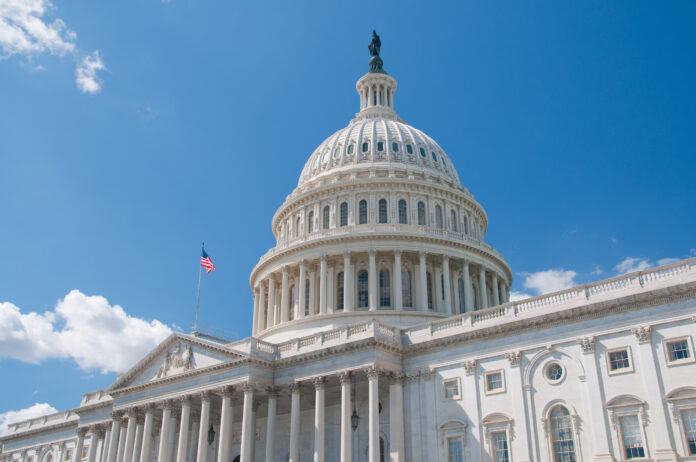(The Center Square) – The federal government spent $1.8 trillion more than it collected in tax revenue in fiscal year 2024, according to figures released Friday by U.S. Treasury Department.
Congress has run a deficit every year since 2001. In the past 50 years, the federal government has ended with a fiscal year-end budget surplus four times, most recently in 2001.
The deficit for fiscal 2024 was $1.8 trillion, or $138 billion higher than the prior year’s deficit. As a percentage of GDP, the deficit was 6.4%, an increase from 6.2% in fiscal 2023. The 2024 deficit is $196 billion lower than in 2023, excluding the effect of the Supreme Court’s 2023 decision in Biden v. Nebraska regarding student loan programs, according to year-end data from the September 2024 Monthly Treasury Statement of Receipts and Outlays of the United States Government.
The fiscal year 2024 deficit was $76 billion below the baseline estimate of $1.91 trillion in the 2024 budget published in March, and $144 billion lower than the baseline estimate of $1.98 trillion in the Mid-Session Review, a supplemental update to the budget published in July.
Maya MacGuineas, president of the Committee for a Responsible Federal Budget, said that is equal to borrowing about $5 billion a day, adding daily to the nation’s $35.76 trillion debt.
“We’re borrowing nearly double the amount we borrowed annually before the pandemic, and this is projected to grow indefinitely,” she said. “This is no way to run a country. In fact, the way we have been running the country is we don’t pass budgets; we don’t pay for new policies; we don’t address our major entitlement programs, which are facing insolvency; and we tolerate the two major presidential candidates competing over who can promise to give away more.”
Both leading major party presidential candidates – Vice President Kamala Harris and former President Donald Trump – have proposed spending and taxation programs that would add to the federal deficit.
The Committee for A Responsible Federal Budget, a nonprofit group, estimates that both Harris’ plan and Trump’s plan would increase the debt. The group estimated that Trump’s plan would cost more than double Harris’ plan. It also noted areas of marked uncertainty in both candidates’ plans. Harris’ plan would increase the debt by $3.50 trillion through 2035, while Trump’s plan would increase the debt by $7.50 trillion, according to the Committee for A Responsible Federal Budget’s analysis.
In fiscal year 2024, the U.S. government spent nearly $900 billion on interest on the debt alone.
“That’s more than we spent on national defense, Medicare, and children at the federal level – just a truly astounding figure,” MacGuineas said. “The national debt is on track to reach a record share of the economy in just two years, a sobering milestone for both the next Congress and whoever wins the presidency in November.”
The next president will take over the nation’s $35.2 trillion in debt.
Congress has continued to spend money it doesn’t have despite warnings.
Earlier this month, credit-rating agency Moody’s sounded the alarm.
“The incoming administration will face a deteriorating U.S. fiscal outlook, as declining debt affordability will gradually weaken U.S. fiscal strength,” Moody’s warned in a recent report. “In the absence of policy measures that can curb these trends and help limit fiscal deficits, deteriorating fiscal strength will increasingly weigh on the U.S. sovereign credit profile.”
Neither presidential candidate has outlined specific plans to address the national debt before the Nov. 5 presidential election.
In March, the Congressional Budget Office projected the deficit would reach 8.5% of gross domestic product by 2054.
The International Monetary Fund warned in May that U.S. government spending and increasing national debt were not sustainable and could hurt the global economy.
In February, a Congressional watchdog told President Joe Biden and Congress that the federal government was on an “unsustainable long-term fiscal path.”
Moody’s projected growing deficits without significant changes.
“We expect the federal government to run large fiscal deficits that average around 7% of GDP per year over the next five years and rise to nearly 9% by 2034, which would drive the debt burden to around 130% of GDP by 2034 from 97% in 2023,” the report noted.
The cost of servicing that debt will also grow.
“We expect federal interest payments relative to revenue and GDP to double to around 30% and 5% by 2034, respectively, from 14.8% and 2.4% in 2023,” according to the report.
Congress and the next president will start 2025 facing two key financial challenges: the reinstatement of the debt limit, the end of discretionary spending caps, and the expiration of large parts of the tax code set in the 2017 Tax Cuts and Jobs Act.
“We need to put our national debt on a downward sustainable trajectory,” MacGuineas said. “Failure to do so will result in a smaller economy, higher interest rates, increased geopolitical threats, generational inequity, and a higher likelihood of a fiscal crisis.”
Secretary of the Treasury Janet Yellen praised the Biden administration for its budget work.
“The Biden-Harris Administration remains focused on our economy’s long-term growth, which includes sustaining historic investments in infrastructure, advanced manufacturing, and clean energy while also addressing our long-term fiscal outlook,” she said in a statement. “The Budget put forward by President Biden reduces the deficit by $3 trillion by asking corporations and the wealthiest Americans to pay their fair share, while preserving our important investments in our country’s future.”




